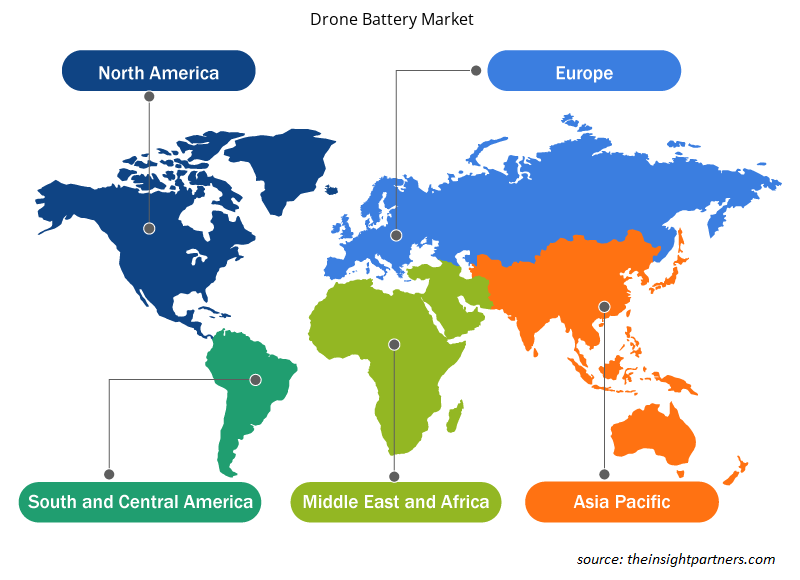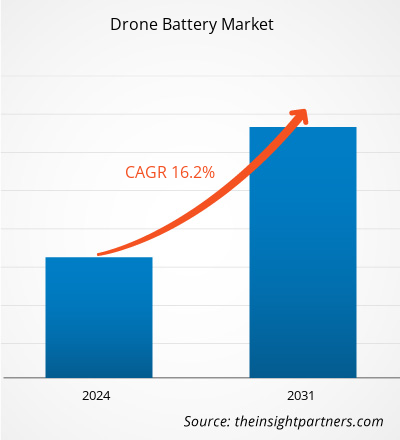ドローン用バッテリー市場規模は、2023年の11億9,976万米ドルから2031年には39億8,283万米ドルに達すると予測されています。市場は2023年から2031年の間に16.2%のCAGRを記録すると予想されています。高性能ドローンの研究開発への注目が高まることは、市場の主要なトレンドであり続けると思われます。
ドローンバッテリー市場分析
世界のドローンバッテリー市場は、測量、マッピング、監視など、さまざまな用途でのドローンの採用の増加によって主に推進されています。さらに、ドローンスタートアップ企業の増加も、ドローンバッテリー市場の世界的な拡大を牽引しています。たとえば、インドでのドローンスタートアップの総数は、2021年8月から2022年2月の間に34%増加しました。このような要因は、インドのドローンバッテリー市場にチャンスをもたらしています。
ドローンバッテリー市場の概要
ドローン バッテリーは、ドローンに使用できる充電式バッテリーです。一般的にはリチウムイオン ポリマー (Li-ion) またはリチウム ポリマー (LiPo) で作られており、さまざまなサイズと容量があります。ドローン バッテリーは、より長い飛行時間のために必要であり、適切に取り扱われないと火災の危険があります。ドローンが使用するバッテリーの種類は、使用間の充電時間や放電率など、ドローンの機能に重要な要素となる場合があります。最も広く使用されているドローン バッテリーは、リチウム ポリマー (LiPo)、ニッケル カドミウム (NiCad)、およびリチウムイオン(Li-ion) バッテリーです。
要件に合わせてレポートをカスタマイズする
このレポートの一部、国レベルの分析、Excelデータパックなど、あらゆるレポートを無料でカスタマイズできます。また、スタートアップや大学向けのお得なオファーや割引もご利用いただけます。
- このレポートの主要な市場動向を入手してください。この無料サンプルには、市場動向から見積もりや予測に至るまでのデータ分析が含まれます。
ドローンバッテリー市場の推進要因と機会
ドローン用リチウム電池の技術的進歩
ドローンはここ数年、世界的に著しい成長を遂げています。国境警備や敵の不法侵入の強化により、多くの政府や企業がUAVの調達に注力しています。例えば、2022年に連邦航空局(FAA)は、2023年に米国で855,860台のドローンが登録されたと報告しました。したがって、ドローンの需要の増加に伴い、バッテリー市場は予測期間中に大幅に成長し続けると予想されます。さらに、最近結成されたチェコ無人航空連盟、フランスのl'Association du drone de l'industrie française(ADIF)、および韓国ドローン産業協会、韓国ドローン協会、深センUAV産業協会、日本UAS産業振興協会など、アジアの多数の国別ドローン協会の増加も、ドローンバッテリー市場の成長を補完しています。
ドローン用バッテリーに関する最先端技術の開発
市場プレーヤーは、充電電圧を上げることで内部抵抗の低いバッテリーを継続的に開発しています。これらのバッテリーは、より長い飛行時間に必要な高密度、高セル容量、低質量、最大電力密度を備えたドローンをサポートします。Amprius TechnologiesやKULR TECHNOLOGY GROUP, INC.などのメーカーも、エネルギー密度400Wh/kg、充電/放電サイクルが少なくとも1,000回の次世代バッテリーを開発しています。したがって、ドローンバッテリーに関連する最先端技術の開発は、予測期間中に市場の成長に有利な機会を生み出すと予想されます。
ドローンバッテリー市場レポートのセグメンテーション分析
ドローンバッテリー市場分析の導出に貢献した主要なセグメントは、ドローンの種類、バッテリーの種類、バッテリー容量、および業界です。
- ドローンの種類に基づいて、ドローンバッテリー市場はミニクワッドとマイクロクワッドに分かれています。ミニクワッドセグメントは2023年に大きな市場シェアを占めました。
- バッテリーの種類別に見ると、市場は NiCad、NiMH、LiPo に分類されます。
- バッテリー容量別に見ると、市場は 3,000 mAh 未満、3,000~5,000 mAh、5,000~10,000 mAh、10,000 mAh 以上に分類されます。
- 業界別に見ると、市場は農業・林業、インフラ検査、公共事業、建設、鉱業、その他に分類されています。
ドローンバッテリー市場シェアの地域別分析
ドローンバッテリー市場レポートの地理的範囲は、主に北米、アジア太平洋、ヨーロッパ、中東およびアフリカ、南米および中米の 5 つの地域に分かれています。
ドローン用バッテリー市場は北米が独占しています。これらの投資と資金提供は、ドローンプロバイダーが事業を拡大し、さまざまな分野のエンドユーザーにソリューションを提供するのに役立つと期待されています。ドローンの需要の高まりにより、北米でのバッテリーの需要が高まり、この地域のドローン用バッテリー市場に利益をもたらす可能性があります。
ドローンバッテリー市場の地域別分析
予測期間を通じてドローン バッテリー市場に影響を与える地域的な傾向と要因は、Insight Partners のアナリストによって徹底的に説明されています。このセクションでは、北米、ヨーロッパ、アジア太平洋、中東、アフリカ、南米、中米にわたるドローン バッテリー市場のセグメントと地理についても説明します。

- ドローンバッテリー市場の地域別データを入手
ドローンバッテリー市場レポートの範囲
| レポート属性 | 詳細 |
|---|---|
| 2023年の市場規模 | 11億9,976万米ドル |
| 2031年までの市場規模 | 39億8,283万米ドル |
| 世界のCAGR(2023年~2031年) | 16.2 % |
| 履歴データ | 2021-2022 |
| 予測期間 | 2024-2031 |
| 対象セグメント | ドローンの種類別
|
| 対象地域と国 | 北米
|
| 市場リーダーと主要企業プロフィール |
|
ドローンバッテリー市場のプレーヤー密度:ビジネスダイナミクスへの影響を理解する
ドローンバッテリー市場は、消費者の嗜好の変化、技術の進歩、製品の利点に対する認識の高まりなどの要因により、エンドユーザーの需要が高まり、急速に成長しています。需要が高まるにつれて、企業は提供を拡大し、消費者のニーズを満たすために革新し、新たなトレンドを活用し、市場の成長をさらに促進しています。
市場プレーヤー密度とは、特定の市場または業界内で活動している企業または会社の分布を指します。これは、特定の市場スペースに、その規模または総市場価値と比較して、どれだけの競合相手 (市場プレーヤー) が存在するかを示します。
ドローンバッテリー市場で事業を展開している主要企業は次のとおりです。
- アミット インダストリーズ株式会社
- アンペレックステクノロジーリミテッド
- オーテルロボティクス
- MMC-UAV
- SES AI株式会社
- パロットドローンSAS
免責事項:上記の企業は、特定の順序でランク付けされていません。

- ドローンバッテリー市場のトップキープレーヤーの概要を入手
ドローンバッテリー市場のニュースと最近の動向
ドローン バッテリー市場は、主要な企業出版物、協会データ、データベースなどの一次調査と二次調査を経て定性的および定量的データを収集することで評価されます。ドローン バッテリー市場の動向のいくつかを以下に示します。
- RRC Power Solutions GmbH は、供給不足を防ぐためにデュアルソーシング戦略を採用しました。この戦略により、同社は RRC2054 などの既存の標準バッテリーパックを開発し、より短い納期で製品の発売を計画することができます。(出典: RRC Power Solutions GmbH、プレスリリース、2022 年 5 月)
- EaglePicher Technologies は、NASA のアルテミス I 打ち上げで使用されたオリオン宇宙船乗組員モジュールとスペース ローンチ システム (SLS) 飛行終了システムの両方に電力を供給する重要なバッテリー技術を提供しました。EaglePicher Technologies は、通信、推進、ナビゲーション、熱制御で構成される乗組員モジュールに電力を供給する 120 ボルトの充電式リチウムイオン バッテリーを提供しています。(出典: EaglePicher Technologies、プレス リリース、2023 年 8 月)
ドローンバッテリー市場レポートの対象範囲と成果物
「ドローンバッテリー市場規模と予測(2021〜2031年)」レポートでは、以下の分野をカバーする市場の詳細な分析を提供しています。
- 対象範囲に含まれるすべての主要市場セグメントについて、世界、地域、国レベルでのドローンバッテリー市場規模と予測
- ドローンバッテリー市場の動向、推進要因、制約、主要な機会などの市場動向
- 詳細なPEST/ポーターの5つの力とSWOT分析
- ドローン用バッテリー市場分析では、主要な市場動向、世界および地域の枠組み、主要プレーヤー、規制、最近の市場動向を取り上げています。
- ドローンバッテリー市場における市場集中、ヒートマップ分析、主要プレーヤー、最近の動向を網羅した業界展望と競争分析
- 詳細な企業プロフィール
- 過去2年間の分析、基準年、CAGRによる予測(7年間)
- PEST分析とSWOT分析
- 市場規模価値/数量 - 世界、地域、国
- 業界と競争環境
- Excel データセット



Report Coverage
Revenue forecast, Company Analysis, Industry landscape, Growth factors, and Trends

Segment Covered
This text is related
to segments covered.

Regional Scope
North America, Europe, Asia Pacific, Middle East & Africa, South & Central America

Country Scope
This text is related
to country scope.
よくある質問
North America dominates the drone battery market.
Technological advancements in lithium batteries for drones and the development of cutting-edge technologies associated with drone batteries are the major factors that propel the global drone battery market.
The key players holding majority shares in the global drone battery market are AMIT Industries L.T.D, Amperex Technology Limited, Autel Robotics, MMC-UAV, SES AI Corporation, Parrot Drone SAS, Maxamps, Shenzhen Grepow Battery Co, DJI, and RRC Power Solutions.
Increasing focus on research and development of high-performance drones is anticipated to play a significant role in the global drone battery market in the coming years.
The expected CAGR of the global drone battery market is 16.2 %.
The global drone battery market is expected to reach US$ 3982.83 million by 2031.
Trends and growth analysis reports related to Electronics and Semiconductor : READ MORE..
The Insight Partners performs research in 4 major stages: Data Collection & Secondary Research, Primary Research, Data Analysis and Data Triangulation & Final Review.
- Data Collection and Secondary Research:
As a market research and consulting firm operating from a decade, we have published and advised several client across the globe. First step for any study will start with an assessment of currently available data and insights from existing reports. Further, historical and current market information is collected from Investor Presentations, Annual Reports, SEC Filings, etc., and other information related to company’s performance and market positioning are gathered from Paid Databases (Factiva, Hoovers, and Reuters) and various other publications available in public domain.
Several associations trade associates, technical forums, institutes, societies and organization are accessed to gain technical as well as market related insights through their publications such as research papers, blogs and press releases related to the studies are referred to get cues about the market. Further, white papers, journals, magazines, and other news articles published in last 3 years are scrutinized and analyzed to understand the current market trends.
- Primary Research:
The primarily interview analysis comprise of data obtained from industry participants interview and answers to survey questions gathered by in-house primary team.
For primary research, interviews are conducted with industry experts/CEOs/Marketing Managers/VPs/Subject Matter Experts from both demand and supply side to get a 360-degree view of the market. The primary team conducts several interviews based on the complexity of the markets to understand the various market trends and dynamics which makes research more credible and precise.
A typical research interview fulfils the following functions:
- Provides first-hand information on the market size, market trends, growth trends, competitive landscape, and outlook
- Validates and strengthens in-house secondary research findings
- Develops the analysis team’s expertise and market understanding
Primary research involves email interactions and telephone interviews for each market, category, segment, and sub-segment across geographies. The participants who typically take part in such a process include, but are not limited to:
- Industry participants: VPs, business development managers, market intelligence managers and national sales managers
- Outside experts: Valuation experts, research analysts and key opinion leaders specializing in the electronics and semiconductor industry.
Below is the breakup of our primary respondents by company, designation, and region:

Once we receive the confirmation from primary research sources or primary respondents, we finalize the base year market estimation and forecast the data as per the macroeconomic and microeconomic factors assessed during data collection.
- Data Analysis:
Once data is validated through both secondary as well as primary respondents, we finalize the market estimations by hypothesis formulation and factor analysis at regional and country level.
- Macro-Economic Factor Analysis:
We analyse macroeconomic indicators such the gross domestic product (GDP), increase in the demand for goods and services across industries, technological advancement, regional economic growth, governmental policies, the influence of COVID-19, PEST analysis, and other aspects. This analysis aids in setting benchmarks for various nations/regions and approximating market splits. Additionally, the general trend of the aforementioned components aid in determining the market's development possibilities.
- Country Level Data:
Various factors that are especially aligned to the country are taken into account to determine the market size for a certain area and country, including the presence of vendors, such as headquarters and offices, the country's GDP, demand patterns, and industry growth. To comprehend the market dynamics for the nation, a number of growth variables, inhibitors, application areas, and current market trends are researched. The aforementioned elements aid in determining the country's overall market's growth potential.
- Company Profile:
The “Table of Contents” is formulated by listing and analyzing more than 25 - 30 companies operating in the market ecosystem across geographies. However, we profile only 10 companies as a standard practice in our syndicate reports. These 10 companies comprise leading, emerging, and regional players. Nonetheless, our analysis is not restricted to the 10 listed companies, we also analyze other companies present in the market to develop a holistic view and understand the prevailing trends. The “Company Profiles” section in the report covers key facts, business description, products & services, financial information, SWOT analysis, and key developments. The financial information presented is extracted from the annual reports and official documents of the publicly listed companies. Upon collecting the information for the sections of respective companies, we verify them via various primary sources and then compile the data in respective company profiles. The company level information helps us in deriving the base number as well as in forecasting the market size.
- Developing Base Number:
Aggregation of sales statistics (2020-2022) and macro-economic factor, and other secondary and primary research insights are utilized to arrive at base number and related market shares for 2022. The data gaps are identified in this step and relevant market data is analyzed, collected from paid primary interviews or databases. On finalizing the base year market size, forecasts are developed on the basis of macro-economic, industry and market growth factors and company level analysis.
- Data Triangulation and Final Review:
The market findings and base year market size calculations are validated from supply as well as demand side. Demand side validations are based on macro-economic factor analysis and benchmarks for respective regions and countries. In case of supply side validations, revenues of major companies are estimated (in case not available) based on industry benchmark, approximate number of employees, product portfolio, and primary interviews revenues are gathered. Further revenue from target product/service segment is assessed to avoid overshooting of market statistics. In case of heavy deviations between supply and demand side values, all thes steps are repeated to achieve synchronization.
We follow an iterative model, wherein we share our research findings with Subject Matter Experts (SME’s) and Key Opinion Leaders (KOLs) until consensus view of the market is not formulated – this model negates any drastic deviation in the opinions of experts. Only validated and universally acceptable research findings are quoted in our reports.
We have important check points that we use to validate our research findings – which we call – data triangulation, where we validate the information, we generate from secondary sources with primary interviews and then we re-validate with our internal data bases and Subject matter experts. This comprehensive model enables us to deliver high quality, reliable data in shortest possible time.


 このレポートの無料サンプルを入手する
このレポートの無料サンプルを入手する